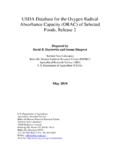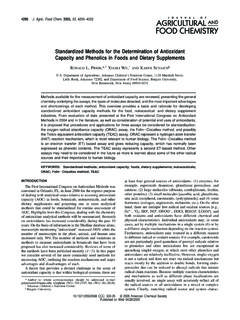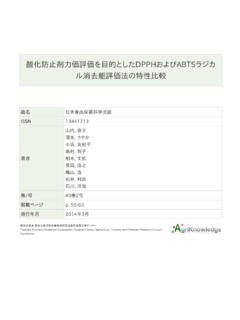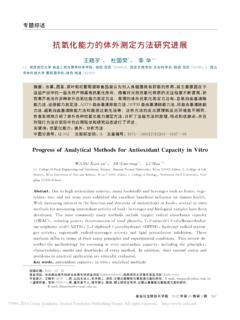Transcription of ORAC Assay for the determination of antioxidant capacity ...
1 Application Note 1 ORAC Assay for the determination of antioxidant capacity in foods Measuring oxygen radical absorbance capacity with the Infinite 200 PRO multimode reader Introduction Reactive oxygen species (ROS) are generated as natural by-products of the cellular metabolism. They are involved in various biological processes, functioning as important signal mediators. However, excess intracellular levels of ROS may result in cell and tissue damage, and are associated with degenerative diseases, most notably cancer. In healthy individuals, intracellular antioxidant systems maintain ROS levels below a critical threshold, permitting essential ROS-mediated signaling processes to function, but preventing ROS overproduction and potential tissue damage [1]. Cells that fail to compensate and neutralize heightened ROS levels die by apoptosis to avoid passing on ROS-caused DNA damage to daughter cells.
2 Any dysfunctions in the cellular antioxidant systems can therefore have serious consequences. In addition to the cells own antioxidant systems, various studies have suggested a relationship between an antioxidant -rich diet and a good health status, implicating that the consumption of antioxidant -containing foods can help to maintain health and even prevent certain diseases [2]. A well-established and reliable method to determine the antioxidant capacity of a substance is the oxygen radical absorbance capacity (ORAC) Assay [3]. It is based on the inhibition of oxyradical-induced oxidation of 2,2 -azobis-(2-methylpropionamidine) dihydrochloride (AAPH) by substances with antioxidant properties. Peroxyl radicals produced in a time-dependent manner during the thermal decomposition of AAPH will quench the fluorescence signal.
3 In the presence of a substance with antioxidant properties the fluorescence reduction is inhibited, depending on the substance s ORAC capacity . The dynamics of the signal inhibition, expressed as the area under the curve (AUC), are used to quantify the antioxidant capacity , expressed as the ORAC value, by comparing the sample AUC to an antioxidant standard curve generated with Trolox, a water-soluble vitamin E analog. This application note describes the use of the Infinite F200 PRO in combination with a commercially available ORAC Assay kit, using different beverages as antioxidant samples. Application Note 2 Materials and Methods Black 96-well microplates (Greiner Bio-One) Black 384-well microplates (Greiner Bio-One) OxiSelect ORAC Activity Assay (Cell Biolabs, Inc.)
4 Phosphate buffered saline (PBS) Infinite F200 PRO The ORAC values of different beverages were determined in the Infinite F200 PRO, using the OxiSelect ORAC Activity Assay by Cell Biolabs, Inc [4]. The following beverages were tested: apple juice, blackcurrant juice, grapefruit juice, orange juice, pineapple juice, red grape juice and red wine. The fruit juices and red wine were obtained from a local supermarket. Care was taken to purchase only 100 % pure juices. The OxiSelect Assay was performed according to the manufacturer s instructions [4]. The standard curve was generated by diluting Trolox from M in PBS. 96-well plate 384-well plate Fluorescein [10 nM] 150 l 75 l Trolox or sample 25 l l PBS 25 l l Total volume/well 200 l 100 l Table 1 Assay reagent mix in 96- and 384-well plates.
5 The Assay plates were covered with sealing film to minimize evaporation and incubated for 30 min at 37 C using the instrument s incubation function. Fluorescence measurements were taken every 60 seconds (see instrument settings summarized in Table 2). After the first three cycles (representing the baseline signal), AAPH was injected into each well to initiate the ROS generation. Measurement mode Fluorescence Intensity Top Excitation wavelength 485 (20) nm Emission wavelength 535 (25) nm Kinetic cycles 60-100 Kinetic interval 60 sec Kinetic condition Inject AAPH after cycle 3: 96-well: 25 l 384-well: l Flash number 10 Gain optimal Lag time 0 s Integration time 20 s Table 2 Instrument settings for ORAC Assay .
6 Results An antioxidant standard curve was generated using different concentrations of Trolox. Figure 1 shows the dose-dependent loss of fluorescence induced by the addition of AAPH. The measured fluorescence values were normalized to 100 %, with 100 % reflecting the initial fluorescence signals after the addition of AAPH. 0204060801000 102030405060time [min]normalized fluorescence intensity [%]50 M Trolox 25 M Trolox M Trolox M Trolox M Trolox BlankFigure 1 Signal curves measured for different Trolox concentrations (results normalized to initial fluorescence signals after AAPH addition). Application Note 3 The antioxidant capacity , expressed as the AUC, was calculated as follows: AUC = 1 + RFU1/RFU0 + RFU2/RFU0 + RFU3/RFU0 + + RFUn/RFU0 RFU0 = relative fluorescence units at time point zero RFUn = relative fluorescence units at time points The Net AUC values, reflecting the blank-corrected AUC values for each standard, were plotted against the Trolox concentrations, and the linearity of the standard curve was calculated (Figure 2).
7 R2 = [ M ]Net AUC Figure 2 Trolox standard curve. During the analysis of the beverage samples, it became evident that some samples could not be analyzed in an undiluted state, because they reduced the fluorescence signal even in the absence of the ROS-generating agent (AAPH). The individual fluorescence quenching potential was assessed for all samples using dilutions from 1:1 to 1:1000. The impact on the fluorescence signal for two example beverages is shown in Figure 3. In both cases, significant signal quenching was observed with undiluted fluids. This effect was also apparent in the 1:2 and 1:10 dilutions, and gradually disappeared when the samples were diluted further. Therefore, 1:100 dilutions of the beverages were used in all further analyses. All fruit juice dilutions were freshly prepared prior to each experiment.
8 Results measured in 96- and 384-well plates were similar; the results shown in the following section were obtained in 96-well plates. 020406080100120undiluted1:21:101:1001:50 01:1000dilutionnormalized fluorescence intensity [%]red winepineapple juiceFigure 3 Fluorescence quenching by fruit juices at different dilutions. As shown in Figure 4, the beverages analyzed exhibited different signal kinetics and antioxidant capacities. The highest antioxidant potential was seen with red wine. Among the non-alcoholic beverages, blackcurrant and grapefruit juices were the most potent antioxidants , while orange and pineapple juices showed the least antioxidant potential. 0204060801000 10 2030 405060 7080 90100time [min]normalized fluorescence intensity [%]blackcurrantred w ineappleorangegrapef ruitpineapplered grape Figure 4 Signal curves for different beverage samples (all used in 1:100 dilution).
9 The ORAC values of the samples can be extrapolated from the Trolox standard curve. Table 3 summarizes the calculated ORAC values of the samples tested. Application Note 4 Australia +61 3 9647 4111 Austria +43 62 46 89 33 Belgium +32 15 42 13 19 China +86 21 2206 3206 Denmark +45 70 23 44 50 France +33 4 72 76 04 80 Germany +49 79 51 94 170 Italy +39 02 92 44 790 Japan +81 44 556 73 11 Netherlands +31 18 34 48 174 Singapore +65 644 41 886 Spain +34 93 490 01 74 Sweden +46 31 75 44 000 Switzerland +41 44 922 89 22 UK +44 118 9300 300 USA +1 919 361 5200 Other countries +41 44 922 8125 Tecan Group Ltd. makes every effort to include accurate and up-to-date information within this publication; however, it is possible that omissions or errors might have occurred.
10 Tecan Group Ltd. cannot, therefore, make any representations or warranties, expressed or implied, as to the accuracy or completeness of the information provided in this publication. Changes in this publication can be made at any time without notice. For technical details and detailed procedures of the specifications provided in this document please contact your Tecan representative. This publication may contain reference to applications and products which are not available in all markets. Please check with your local sales representative. All mentioned trademarks are protected by law. In general, the trademarks and designs referenced herein are trademarks, or registered trademarks, of Tecan Group Ltd., M nnedorf, Switzerland. A complete list may be found at Product names and company names that are not contained in the list but are noted herein may be the trademarks of their respective owners.




